Pig Farms Lighting Design: Best Light for Pig House
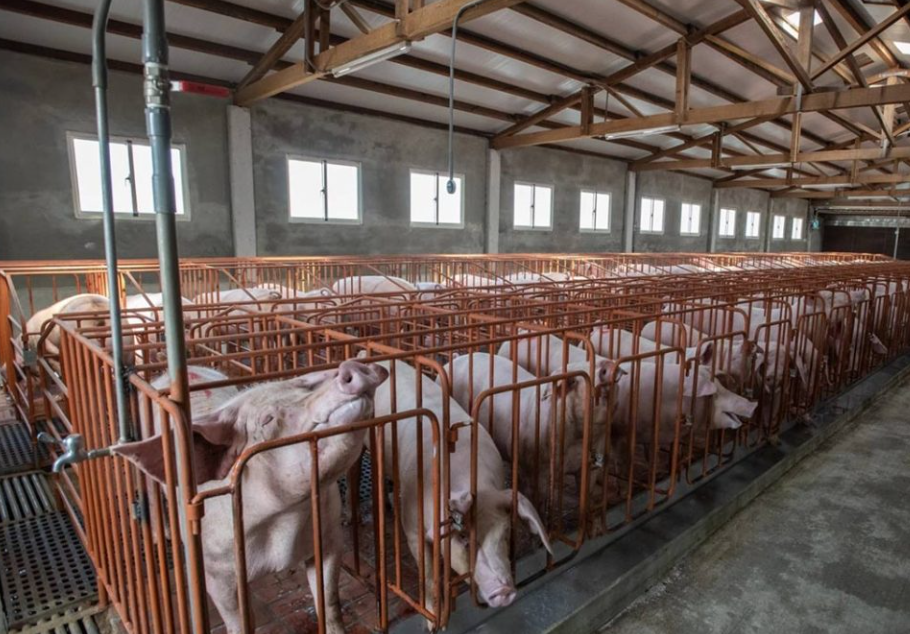
Directory:
1. The Influence of Light on Pigs
2. Pig House Lighting Design
3. Best Light for Pig House
In recent years, pig farming has increasingly shifted towards closed and factory-based systems, leading to significant advancements in environmental control systems for pig housing. Currently, these systems primarily focus on managing temperature, humidity, and harmful gases, while the regulation of light conditions is often overlooked. Research indicates that the lighting environment can have both direct and indirect effects on the production performance of pigs, thereby influencing the overall efficiency of pig farms. The use of artificial lighting technology in pig houses, which provides appropriate light sources for pigs, ranks second in energy consumption after ventilation fans within the entire farm. Consequently, developing a well-structured lighting management system for pig houses is crucial for enhancing production efficiency as well as for energy conservation and emission reduction.
1. The Influence of Light on Pigs
The lighting environment in pig houses is characterized by light intensity and duration. Unlike humans, pigs possess only two types of cone pigments for color recognition, allowing them to see only blue and green, making them less sensitive to light colors. The European Livestock Association mandates that pigs must be provided with a minimum light level of 40 Lux for at least 8 hours daily, which serves as a basic welfare requirement. However, further exploration is necessary to find a balance between production efficiency and animal welfare.
1.1 Impact of Light on Sows
Adequate lighting can enhance estrus in sows. Extending the duration of light exposure positively influences the reproductive system of sows and the development of embryos. By increasing light exposure, the hypothalamus in reserve sows is stimulated, leading to decreased melatonin secretion and increased production of gonadotropin-releasing hormone. This, in turn, prompts the anterior pituitary to boost the secretion of follicle-stimulating hormone and luteinizing hormone, accelerating follicle maturation and advancing the onset of estrus. Research by Peng Guiyou indicated that providing 16 hours of light daily can advance the first estrus of Rongchang pigs by 18.5 days and increase litter size by 2.8 piglets. Anssi Tast and colleagues found that light intensities of 200 Lux and 1.000 Lux do not effectively reduce melatonin secretion in sows compared to 40 Lux, suggesting that simply increasing light intensity does not induce estrus in gilts. Therefore, an appropriate light intensity is beneficial not only for stimulating estrus in gilts but also for reducing energy consumption in pig houses.
The impact of light on sows is evident in various factors such as conception rates, litter size, and milk production. Tian Yunbo noted that increasing the light intensity in breeding sow housing from 6 Lux to 8 Lux, and then to 70 Lux and 100 Lux, results in improvements in litter size, birth weight, litter weight, average daily weight gain, and weaning litter weight, with increases ranging from 4.5% to 8.5%, 4.5% to 16.7% (0.7 kg to 1.6 kg), 5.6%, and 5.1% to 12.2%, respectively. Mabry JW and colleagues found that providing 1 hour of light per day during lactation, compared to 8 hours, significantly boosts the number of piglets weaned at 21 days of age (P < 0.05). This may be attributed to longer light exposure enhancing the number of piglets that can nurse (P < 0.05), with no significant difference in the amount of milk produced by the sows. The American Society of Agricultural Bioengineering suggests that the ideal light intensity for pregnant or reserve sows is around 100 Lux, with light exposure lasting 14 to 16 hours daily.
1.2 Impact of Light on Piglets
Light plays a crucial role in the immune function and metabolism of piglets. Niekamp SR and others indicated that the light cycle's influence on piglet immune function may begin during the sow's pregnancy. Piglets born to sows exposed to 16 hours of light daily during pregnancy showed better immune status at 14 days old compared to those from the 12-hour light group. In the nursery phase, heat lamps commonly used to warm piglets rely on infrared light's thermal effects. However, traditional heat lamps produce a significant amount of visible light without thermal benefits, leading to energy waste. Alternatives like heating plates or lightless heat lamps are more efficient. Feng Zhiliang reported that increasing light intensity from 10 Lux to 60 Lux and then to 100 Lux reduces the incidence of health issues in piglets by 24.8% to 28.6%, increases survival rates by 19.7% to 31.0%, and boosts daily weight gain by 0.9 kg to 1.8 kg. However, when light intensity reaches 350 Lux, its effects are less favorable than at 60 Lux. It is recommended that nursery pigs be exposed to light intensities between 50 Lux and 100 Lux.
1.3 Impact of Light on Fattening Pigs
Increasing light intensity appropriately can enhance the health and resilience of pigs. Research indicates that fattening pigs exposed to 5 Lux of artificial light showed a notable decline in bodily functions compared to those under 40 Lux of natural light. However, when the artificial light was raised to between 40 Lux and 50 Lux, the metabolism of the fattening pigs normalized. It is advised that the light intensity for growing and fattening pigs should generally be set between 40 Lux and 50 Lux. Additionally, the duration of light exposure significantly affects the growth and fattening of pigs. A study by Martelli G et al. compared two light cycles (70 Lux, with light periods of 14:10 and 8:16). The findings revealed that the feed-to-meat conversion ratio for pigs in a longer light period (4.3) was considerably lower than that for those in a shorter light period (5.21) (P < 0.01). Research by Han Dingjiao indicated that within a light duration of 12 to 24 hours, shorter light periods are more beneficial for improving the growth performance of fattening pigs, lowering the feed-to-meat ratio, and reducing illness rates, achieving significant results.
1.4 Impact of Light on Boars
Prolonging light exposure can aid in the development of gonads in young boars and hasten their sexual maturity. When discussing the effects of light on boars, the quality of boar semen is a primary focus. While extending light exposure has minimal impact on semen quality, increasing light intensity significantly enhances it. Research by Cui Maosheng et al. demonstrated that boar semen preserved in vitro under 100 Lux showed a marked improvement compared to those at 50 Lux and 150 Lux. Based on this analysis and the practical needs of pig farms, recommendations for modern pig farm lighting standards are summarized for reference (Table 1).
table1 Pig farm lighting index recommendations
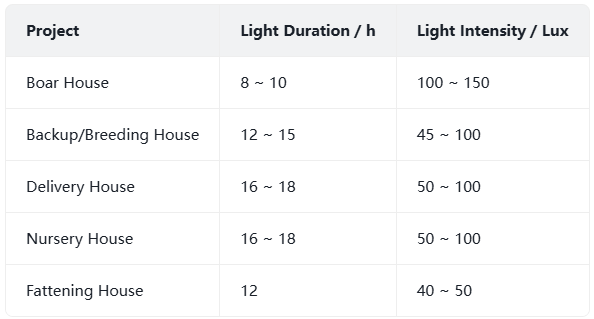
2. Pig House Lighting Design
2.1 Selection of Light Sources
Light consists of electromagnetic waves that range from low to high frequency, including radio waves, infrared, visible light, ultraviolet light, X-rays, and gamma rays (see Figure 1). In pig farming, ultraviolet light is primarily used for sterilization and disinfection, visible light serves for pig farm lighting, and infrared light is mainly utilized for maintaining the warmth of piglets.
When selecting a light source, key factors to consider include luminous flux and luminous intensity. Luminous flux refers to the total energy emitted by the light source over time, measured in lumens (lm), while luminous intensity indicates the light energy emitted within a specific solid angle, reflecting the light's ability to converge, and is measured in candelas (Cd). Light intensity is a crucial metric for assessing lighting effectiveness, defined as the luminous flux of visible light received per unit area, known as illuminance, measured in lux (Lux). It is important to understand that luminous flux and luminous intensity are intrinsic characteristics of the light source and are not influenced by the distance from it. In contrast, light intensity does vary with distance; as one moves further from the light source, its impact diminishes, resulting in lower light intensity. Additionally, light intensity is cumulative, meaning that the intensity at a specific point is the total of all light intensities from all sources directed at that point.
fig1 Solar spectrum

When selecting pig house lighting sources, it's important to consider the energy efficiency ratio of various lamps, which refers to the power needed for each unit of light output. Table 2 displays the energy efficiency ratios of commonly used lamps. A comparison reveals that high-power LED lamps offer the best energy efficiency ratio among these options.
table2 Energy efficiency ratio of common lamps
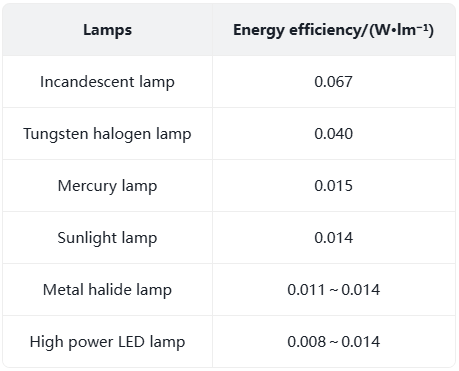
2.2 Arrangement of Light Sources
In this section, LED lamp tubes (18 W, 2.100 lm, 6.500 K) are utilized as individual light sources for the farrowing house. The light intensity profile of the LED lamp tube is illustrated in Figure 2. The necessary light intensity for the farrowing house ranges from 50 Lux to 100 Lux. As shown in Figure 2. the light intensity at a horizontal distance of 2 meters from the center of the lamp tube is 25 Lux. To achieve the desired light intensity, the horizontal spacing between the two lamp tubes is set to 4 meters, resulting in a light intensity of 50 Lux at the midpoint between the two tubes, which satisfies the pig farrowing house lighting requirements.
The professional lighting design software DIALux is employed to simulate the lighting conditions in the farrowing house, with the simulated light intensity results presented in Figure 3. The average light intensity within the house is calculated to be 92.7 Lux, and these simulation results align with the specified requirements.
Field measurements are conducted to verify the simulation results, as shown in Table 3. The measured values are generally lower than those predicted by the software, which may be attributed to light obstruction caused by equipment such as pens and feed lines within the house.
fig2 Light intensity curve of LED lamp
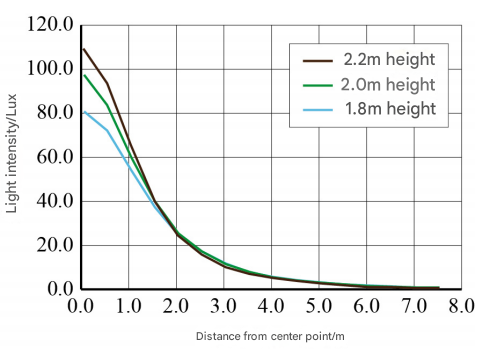
fig3 Lighting design software DIALux simulates farrowing house lighting results
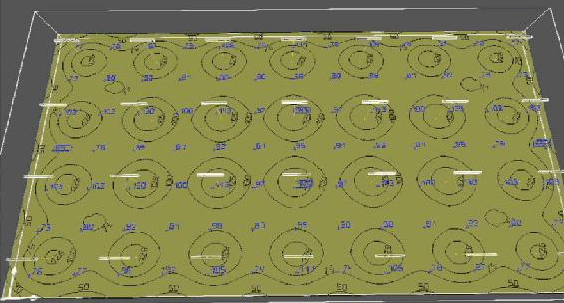
Table 3 Comparison of Field Measured Illumination Intensity Results with Simulation Results

The selection of appropriate lamps and the arrangement of light sources are essential components of pig houses lighting design. Since these facilities require frequent deep cleaning, the durability and protection level of the pig farms lighting fixtures must also be taken into account. Tailoring the lighting design to suit various groups of pigs can greatly enhance the productivity of pig farms. Furthermore, managing the photoperiod is a crucial aspect of pig farms lighting design; however, there is a scarcity of technical data on this topic, and many debates persist regarding the best practices for photoperiod regulation.
3. Best Light for Pig House
3.1 Pig house lights T21
Ceramiclite T21 pig lights are the ideal solution for livestock farms and food processing plants, designed for special places that require high pressure washing, such as car washes and farms. Special ceramic LED, PC material and waterproof structure design can prevent hydrogen sulphide gas, ammonia and other corrosion, the application of ceramic LED makes the resistance to hydrogen sulfide gas more than 4 times the light decay of traditional LED lamps. but also suitable for high temperature and high humidity environments such as mushroom planting room, where often produce a large amount of dust, smoke and water vapour places, it can also be used as a conventional tri-proof lamp.

3.2 Pig house lights T16
Ceramiclite T16 pig lights are an excellent solution specifically designed for environments requiring high-pressure washing. Made from special plastic with a waterproof structure and ceramic light source, their durability reduces maintenance costs, while their long lifespan and energy efficiency provide superior lighting, especially suitable for livestock farms, industrial sites, and food processing facilities.

4. Related Solution & Science
5. Contact Ceramiclite
